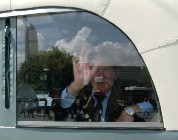
Veterans increasingly start up humanitarian initiatives in countries where they were deployed. This was shown in research commissioned by the National Committee for International Cooperation and Sustainable Development (NCDO) and the Veteran Institute in the Netherlands. Ever since their deployment these veterans have felt concerned about the fate of the Papuans in former Dutch New Guinea. They tend to feel guilty because, from their point of view, the Papuans were betrayed by the Dutch Government.
“ I decided to devote my life to improving the situation for Papuans because I feel guilty about what happened,” one veteran said during the book launch in November 2008 of ‘Veterans with a Mission’, which is about 12 Veteran Projects that were set 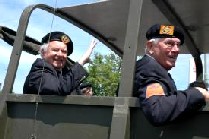 up. One such project involves selling Papuan artefacts from home such as spears, carvings and masks. Most of the profit is used to support Papuans in some way.
up. One such project involves selling Papuan artefacts from home such as spears, carvings and masks. Most of the profit is used to support Papuans in some way.
This theme page provides a brief history of major military events and the activities of veterans deployed in New Guinea up until the handover to Indonesia in 1962.
Content
1. ‘Karel Doorman’ Journey start of escalation
2. New Guinea remained Dutch after Indonesian independence
3. Military reinforcements along the coast
4. Biak as focal point of Air Force
5. The Navy against infiltration
6. Secret negotiations in Middleburgh
7. More reinforcement brought in
8. Navy successes
9. National Veterans Day
10. Links
11. Sources
1. ‘Karel Doorman’ Journey start of escalation
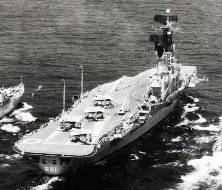 In total 35.000 military soldiers and 1400 marines served in New Guinea. At least 126 men lost their lives during conflicts that arose between Indonesia and the last remaining Dutch colony in the far east.
In total 35.000 military soldiers and 1400 marines served in New Guinea. At least 126 men lost their lives during conflicts that arose between Indonesia and the last remaining Dutch colony in the far east.
When the Netherlands sent in reinforcements on the aircraft carrier the ‘Karel Doorman’, Indonesia immediately broke off diplomatic relations. The display of flags on the impressive ship was intended to impress the world and show up Indonesia as “the enemy”. It was the last attempt of the Netherlands to try and belong to the world leaders. The journey of the ‘Karel Doorman’ marked the starting point of a process of diplomacy and military escalation prior to New Guinea being handed over to Indonesian rule.
The PVK, a Voluntary Military Corps of Papuans, formed part of the Dutch Army in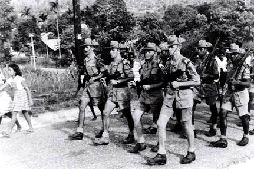 New Guinea and it was set up on 23 February 1961 to assist the Dutch army in the area. After a six months training course,the indigenous soldiers joined military patrols to combat armed Indonesian infiltrators. It is estimated that six Papuan soldiers died during the fighting. The PKV kept going until the official handover of New Guinea to the United Nations on 1 October 1962. This voluntary corps of Papuan soldiers never received any sign of appreciation for their efforts from the Dutch authorities.
New Guinea and it was set up on 23 February 1961 to assist the Dutch army in the area. After a six months training course,the indigenous soldiers joined military patrols to combat armed Indonesian infiltrators. It is estimated that six Papuan soldiers died during the fighting. The PKV kept going until the official handover of New Guinea to the United Nations on 1 October 1962. This voluntary corps of Papuan soldiers never received any sign of appreciation for their efforts from the Dutch authorities.
2. New Guinea remained Dutch after Indonesian independence
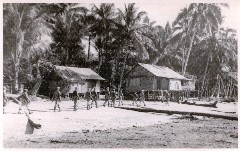 After the Dutch East Indies changed to being the independent country of Indonesia at the end of 1949, New Guinea continued to be a Dutch colony for another 12 years. However, Indonesia kept on laying claims to New Guinea and the political conflict heightened over time. To be able to defend the colony, the Netherlands sent in both air force and military units to New Guinea in 1958. The Navy had been there ever since the end of World War II. On 14 April 1960, the first marines and other military personnel were deployed from the Netherlands and the Netherlands Antillen and flown into New Guinea via an airlift organised by the KLM. The rising tension resulted in a series of armed confrontations. Additional tension was caused by the fact that the Soviet Union stationed six submarines along the coast ten miles out from Manokwari. Together with the Indonesian Military, they intended to put an end to Dutch rule. Some twenty or more Tupolev bombers were also ready to take off for the invasion that was being planned. However, under pressure from the United States the opposing factions came to the negotiation table.
After the Dutch East Indies changed to being the independent country of Indonesia at the end of 1949, New Guinea continued to be a Dutch colony for another 12 years. However, Indonesia kept on laying claims to New Guinea and the political conflict heightened over time. To be able to defend the colony, the Netherlands sent in both air force and military units to New Guinea in 1958. The Navy had been there ever since the end of World War II. On 14 April 1960, the first marines and other military personnel were deployed from the Netherlands and the Netherlands Antillen and flown into New Guinea via an airlift organised by the KLM. The rising tension resulted in a series of armed confrontations. Additional tension was caused by the fact that the Soviet Union stationed six submarines along the coast ten miles out from Manokwari. Together with the Indonesian Military, they intended to put an end to Dutch rule. Some twenty or more Tupolev bombers were also ready to take off for the invasion that was being planned. However, under pressure from the United States the opposing factions came to the negotiation table.
On 15 August 1962, hostilities came to an end by means of the so called ‘New York Agreement’ resulting, after an interim administration period by the United Nations, in New Guinea being handed over to Indonesia. The inhabitants of New Guinea were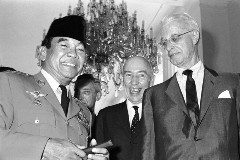 promised a referendum at a later date to choose between self-government or becoming a part of Indonesia. Because of this accord, war between the forces of the two countries was averted. The indigenous Papuan population was not involved at all in the plan developed by the American diplomat Ellsworth Bunker, in which the governance of New Guinea was handed over to the United Nations Temporary Executive Authority(UNTEA).
promised a referendum at a later date to choose between self-government or becoming a part of Indonesia. Because of this accord, war between the forces of the two countries was averted. The indigenous Papuan population was not involved at all in the plan developed by the American diplomat Ellsworth Bunker, in which the governance of New Guinea was handed over to the United Nations Temporary Executive Authority(UNTEA).
3. Military reinforcements along the coast
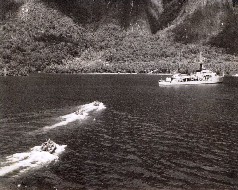 In 1950 extra army units arrived in order to reinforce the existing troops. They were added to detachments in Hollandia, Biak, Manokwari, Sorong, Fak Fak and Kaimana. Documentation indicates that the New Guinea Army (Landmacht Nieuw Guinea or LNG) grew in size to 1576 military men and 175 civilians. The LNG consisted in part of the army and in part of the Royal Dutch East Indies Army ( Koninklijk Nederlands Indisch Leger or KNIL). When the KNIL was abolished, the men joined the LNG. During the existence of this New Guinea Army, there were a total of six enemy infiltrations which were combated by the marines and the police who had joined forces. A number of Indonesians were slain and captured during this combat but no Dutch soldiers were killed in the conflict.
In 1950 extra army units arrived in order to reinforce the existing troops. They were added to detachments in Hollandia, Biak, Manokwari, Sorong, Fak Fak and Kaimana. Documentation indicates that the New Guinea Army (Landmacht Nieuw Guinea or LNG) grew in size to 1576 military men and 175 civilians. The LNG consisted in part of the army and in part of the Royal Dutch East Indies Army ( Koninklijk Nederlands Indisch Leger or KNIL). When the KNIL was abolished, the men joined the LNG. During the existence of this New Guinea Army, there were a total of six enemy infiltrations which were combated by the marines and the police who had joined forces. A number of Indonesians were slain and captured during this combat but no Dutch soldiers were killed in the conflict.
A government committee which visited New Guinea from 13 August to 5 September 1953, advised that this colony with its coastline of 2600 miles or more, was to be defended by the Navy only. This committee thought it best that the defence was to be assigned to the Naval Aviation Fleet and its Marine Corps. So on 28 February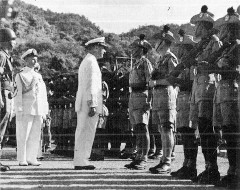 1955 the Dutch Royal Army handed its responsibilities in New Guinea over to the Royal Navy. The official handover took place at Hollandia in the presence of the governor of Dutch New Guinea, Dr. Jan Van Baal. On 15 March 1955, the last group of soldiers (889 men) departed from Hollandia on the ‘Sabajak” and they arrived in Rotterdam on 16 April of that same year. It was not until late 1958, early 1959, that soldiers were active once again in New Guinea.
1955 the Dutch Royal Army handed its responsibilities in New Guinea over to the Royal Navy. The official handover took place at Hollandia in the presence of the governor of Dutch New Guinea, Dr. Jan Van Baal. On 15 March 1955, the last group of soldiers (889 men) departed from Hollandia on the ‘Sabajak” and they arrived in Rotterdam on 16 April of that same year. It was not until late 1958, early 1959, that soldiers were active once again in New Guinea.
4. Biak as focal point of Air Force
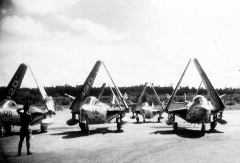 In 1958 the Netherlands sent in military reinforcements to New Guinea, including an air force detachment which was stationed on Biak. First of all, the Air Force installed two radar warning systems, one on Biak and the other on the small island of Woendi situated near by. In 1960 the Air Force was given an assignment, under the code name of ‘Fidelio Plan’, to organize the Commando Air Defence Dutch New Guinea. This consisted of: an Air Force Squadron of 12 Hawker Hunter F Mk 4 Planes and two Alouette helicopters, a radar navigation system on Biak and a reserve air strip on Noemfoer. The planes and helicopters were transported in by the air craft carrier ’Karel Doorman’. A year later, another 12 Hawker Hunter F Mk 6 planes were supplied. These had larger fuel tanks and could fly longer distances.
In 1958 the Netherlands sent in military reinforcements to New Guinea, including an air force detachment which was stationed on Biak. First of all, the Air Force installed two radar warning systems, one on Biak and the other on the small island of Woendi situated near by. In 1960 the Air Force was given an assignment, under the code name of ‘Fidelio Plan’, to organize the Commando Air Defence Dutch New Guinea. This consisted of: an Air Force Squadron of 12 Hawker Hunter F Mk 4 Planes and two Alouette helicopters, a radar navigation system on Biak and a reserve air strip on Noemfoer. The planes and helicopters were transported in by the air craft carrier ’Karel Doorman’. A year later, another 12 Hawker Hunter F Mk 6 planes were supplied. These had larger fuel tanks and could fly longer distances.
The emergence of Squadron 336 (for transport), was very much linked with the military operations in New Guinea. In 1955 the Air Force took over the transport by air from the Navy. Squadron 336 took command of three Dakotas belonging to the Navy and took over three planes from the American Air Force and they started operating from Mokmer airstrip on Biak. From September 1961 until September 1962, more than 5400 passengers as well as freight were transported around New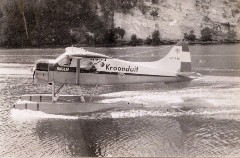 Guinea. In August 1962, Indonesia was all set to start the attack. However, the overall size of the Dutch forces was insufficient to resist a mayor attack on New Guinea. Because of this, as well as the ever mounting political pressure from the United nations, the Dutch Government was more or less forced to hand over New Guinea to Indonesia. The withdrawal of Dutch troops resulted in many aircraft and supplies being left behind and this was regarded as a major victory by the Indonesians.
Guinea. In August 1962, Indonesia was all set to start the attack. However, the overall size of the Dutch forces was insufficient to resist a mayor attack on New Guinea. Because of this, as well as the ever mounting political pressure from the United nations, the Dutch Government was more or less forced to hand over New Guinea to Indonesia. The withdrawal of Dutch troops resulted in many aircraft and supplies being left behind and this was regarded as a major victory by the Indonesians.
5. The Navy against infiltration
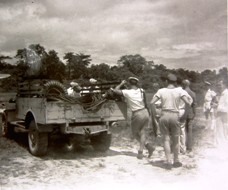 In 1952 Indonesia started to impose pressure by means of infiltrations. The first infiltration of any consequence occurred at the end of January 1952 on the island of Gag.
In 1952 Indonesia started to impose pressure by means of infiltrations. The first infiltration of any consequence occurred at the end of January 1952 on the island of Gag.
Between 1955-58, the Royal Navy consisted of around 2500 men. On 13 November 1960 the army took over from the marines along the south and south-west coast. The marines concentrated on the north coast to be able to act as an operational reserve.
Then on 13 November 1962, a relatively large scale infiltration occurred near the Buru Mountains on the south-west coast of New Guinea. They were not successful as they were cleaned out by the marines, aided by the police and the local population.
A more aggressive Indonesian stance began on15 January 1962 with the attempt of three motorised torpedo boats (the Matjan Tutul, the Hari Mau and the Matjan Kubang) to approach the south coast. They were however defeated by a Neptune aircraft of the Air Force. The Matjan Tulu was hit and caught fire, after which the other two ships took off in south westerly direction. 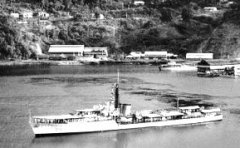 The 52 survivors of the Matjan Tutul were taken prisoner. Another attempt to infiltrate was discovered near Fak Fak on 24 March by another Neptune aircraft. When the ship kept approaching despite several warnings to back off, it was also set on fire by the aircraft that spotted it. On 27 March some thirty Indonesian Infiltrators land near Aidoena on the Jera River. After a month of combat with local marines and police, the area was totally cleared of all infiltrators.
The 52 survivors of the Matjan Tutul were taken prisoner. Another attempt to infiltrate was discovered near Fak Fak on 24 March by another Neptune aircraft. When the ship kept approaching despite several warnings to back off, it was also set on fire by the aircraft that spotted it. On 27 March some thirty Indonesian Infiltrators land near Aidoena on the Jera River. After a month of combat with local marines and police, the area was totally cleared of all infiltrators.
6. Secret negotiations in Middleburgh
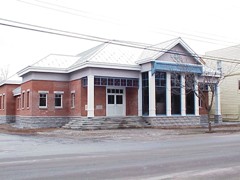 In March 1962, the Netherlands and Indonesia came to an agreement as to how the negotiations were to be conducted. On the 20th of March, the negotiations started under utmost secrecy. They took place in the American town of Middleburgh, near Washington. The American diplomat Bunker mediated between the two parties, officially in name of the UN, but in reality it was on behalf of the United States. He launched a proposal in which New Guinea would initially be supervised by the UN: firstly with help of the Dutch and subsequently with Indonesian assistance. After this interim administration, it would be handed over to Indonesia.
In March 1962, the Netherlands and Indonesia came to an agreement as to how the negotiations were to be conducted. On the 20th of March, the negotiations started under utmost secrecy. They took place in the American town of Middleburgh, near Washington. The American diplomat Bunker mediated between the two parties, officially in name of the UN, but in reality it was on behalf of the United States. He launched a proposal in which New Guinea would initially be supervised by the UN: firstly with help of the Dutch and subsequently with Indonesian assistance. After this interim administration, it would be handed over to Indonesia.
After a certain period of time there was to be ‘an act of free choice’, in which the indigenous population was to decide on becoming part of Indonesia or on becoming an independent nation. This so called ‘Plan Bunker’ met with resistance from both the Dutch and the Indonesians. The Indonesian president kept insisti ng that ‘Irian Barat’ was to be in Indonesian hands by the end of that year. Both parties kept stalling the negotiations which continued on into July 1962. This gave the Indonesians a chance to increase military pressure. They had already organized an attack on 20 March, the day that the negotiations commenced and they were planning to start a massive invasion in case their demands were not met.
ng that ‘Irian Barat’ was to be in Indonesian hands by the end of that year. Both parties kept stalling the negotiations which continued on into July 1962. This gave the Indonesians a chance to increase military pressure. They had already organized an attack on 20 March, the day that the negotiations commenced and they were planning to start a massive invasion in case their demands were not met.
7. More reinforcement brought in
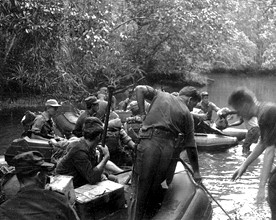 The lengthy consultation process also suited the Dutch as the renewed Indonesian activity made bringing in new reinforcements inevitable. From 28 March 1962 onwards, the forces in New Guinea were supplemented with extra marine units. These reinforcements were shipped and flown in from both the Netherlands and the Netherlands’ Antilles. Simultaneously, Operation ‘Zaltbommel’ took place: Over April and May two battalions of the infantry, two air force units and a number of supplementary provisions were sent to New Guinea. It concerned the 41st Battalion, the 17th Infantry Battalion and 928th and 940th Divisions of the LUA. The strength of the Air Force is increased to two squadrons of Hawker Hunters. A squadron of Neptune aircraft was already in place. The Navy reinforcements consisted of two to three frigates, four hunters and three submarines. By 18 August 1962, the following 11 ships were present in New Guinea: Friesland, Groningen, Limburg, Overijsel, Evertsen, Kortenear, Luymes, Snellius, Pelikaan, Dolfijn, and the Zeeleeuw. Apart from these, there were also three
The lengthy consultation process also suited the Dutch as the renewed Indonesian activity made bringing in new reinforcements inevitable. From 28 March 1962 onwards, the forces in New Guinea were supplemented with extra marine units. These reinforcements were shipped and flown in from both the Netherlands and the Netherlands’ Antilles. Simultaneously, Operation ‘Zaltbommel’ took place: Over April and May two battalions of the infantry, two air force units and a number of supplementary provisions were sent to New Guinea. It concerned the 41st Battalion, the 17th Infantry Battalion and 928th and 940th Divisions of the LUA. The strength of the Air Force is increased to two squadrons of Hawker Hunters. A squadron of Neptune aircraft was already in place. The Navy reinforcements consisted of two to three frigates, four hunters and three submarines. By 18 August 1962, the following 11 ships were present in New Guinea: Friesland, Groningen, Limburg, Overijsel, Evertsen, Kortenear, Luymes, Snellius, Pelikaan, Dolfijn, and the Zeeleeuw. Apart from these, there were also three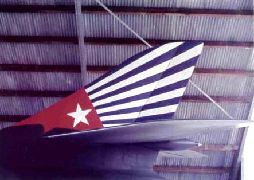 dredges, 16 landing craft , two tugs, 84-zodiac inflatable boats, motor boats, and three auxiliary ships: Duivendrecht, Bussum and Alte Marum. The fleet personnel came to a total of 2956 men. Squadron 321 was stationed on Biak, consisting of 326 air force men as well as a further 1425 marines. The total number of marines came to 4704 men, the number for the army came to 4096 and the Air Force numbered 720 men. The total number of military personnel had doubled by mid 1962, reaching a total of 9523, that is: almost 10.000 men!
dredges, 16 landing craft , two tugs, 84-zodiac inflatable boats, motor boats, and three auxiliary ships: Duivendrecht, Bussum and Alte Marum. The fleet personnel came to a total of 2956 men. Squadron 321 was stationed on Biak, consisting of 326 air force men as well as a further 1425 marines. The total number of marines came to 4704 men, the number for the army came to 4096 and the Air Force numbered 720 men. The total number of military personnel had doubled by mid 1962, reaching a total of 9523, that is: almost 10.000 men!
At this point Indonesia started to use a new strategy, namely the dropping of paratroopers over New Guinea. From April 26 to July 24 1962, paratroopers were being dropped over the Bird's Head Area, and over the Onin Peninsula near Kaimana and Merauke. An estimated 1195 paratroopers were dropped. Combat action against the nearly 1200 parachutists took almost four months. The Indonesian invaders had split up into small groups and they avoided contact. On 30 April 1962 the first 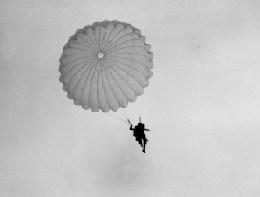 parachutist was captured by the Dutch. Dutch troops, Papua soldiers and police searched constantly for the well hidden Indonesians. By the 18th of August, they had managed to catch around 366 parachutists with the aid of the local population who acted as guides and messengers. An equal number at least was killed or simply died. The rest wandered around in the damp dark jungle.
parachutist was captured by the Dutch. Dutch troops, Papua soldiers and police searched constantly for the well hidden Indonesians. By the 18th of August, they had managed to catch around 366 parachutists with the aid of the local population who acted as guides and messengers. An equal number at least was killed or simply died. The rest wandered around in the damp dark jungle.
8. Naval successes
The Navy patrolled day and night with ships and aircraft along the coast and over land. They attained a number of successes and these include: the arrest of a canoe with twenty infiltrators west of Fak Fak on May 14 by the "Paris", opening fire on and driving off Indonesian aircraft near Kaimana on May 15 by the "Limburg", shooting down a Dakota on May 17 by a Neptune, bombarding parachutists on 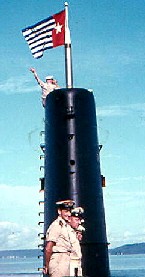 May 21 near Teminaboean, the July 31 attack by one of the
May 21 near Teminaboean, the July 31 attack by one of the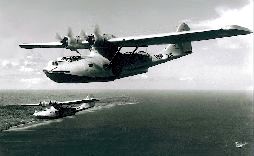 Neptune planes on a submarine near the island Numfor, Support provided by the ship ‘Evertsen’ to marines in action on Onin Peninsula, the support of the ‘Luymus’ to marine actions on Misool island on 10 August as well as holding off an attempt to land there on 11 August with the aid of the ‘Friesland’ and another Neptune aircraft.
Neptune planes on a submarine near the island Numfor, Support provided by the ship ‘Evertsen’ to marines in action on Onin Peninsula, the support of the ‘Luymus’ to marine actions on Misool island on 10 August as well as holding off an attempt to land there on 11 August with the aid of the ‘Friesland’ and another Neptune aircraft.
However, on 18 August 1962 all combat action is called to a halt and the whole fleet as well as all the aircraft left for the Netherlands. As the ‘Groningen and the ‘Evertsen’ left the wharf of Biak, The (forbidden) Papua flag with the morning star was hung from attack periscope of the submarine the ‘Dolfijn’. Especially the Papuans waving goodbye were wildly enthusiastic about this gesture. This formed a sharp contrast with ‘the politics in the Hague’ where questions in the house led to a rebuke for the ship’s commander.
9. National Veterans Day
Many veterans, including the men who were active in new Guinea have joined associations which meet annually. In 2003 the Secretary of Defense, Cees van der Knaap, decided to install a National Veterans Day in the Netherlands. The aim of this Veterans Day is to publicly express recognition for the contribution made by veterans and to promote greater awareness and appreciation for their military service. From 2005 onwards, the Dutch Veteran Day has been held on June 29th (except when this falls on a Sunday), the birth date of Prince Bernhard who died in December 2004. He had always had a special report with the veterans.
this Veterans Day is to publicly express recognition for the contribution made by veterans and to promote greater awareness and appreciation for their military service. From 2005 onwards, the Dutch Veteran Day has been held on June 29th (except when this falls on a Sunday), the birth date of Prince Bernhard who died in December 2004. He had always had a special report with the veterans.
Veterans also hold annual reunions with the particular military units that they 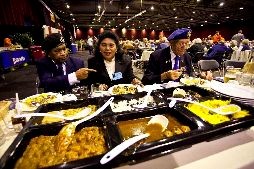 belonged to. For example, on 16 May 2009 around 7000 veterans, who had belonged to the ‘Koninklijke Landmacht’( Royal Army) up until 1962 and who had served in the Dutch East Indies, Former Dutch New Guinea and Korea, all met at the Ijsel Hall in Zwolle. Dozens of chefs and kitchen staff worked on preparing meals for this occasion, including many Indonesian favourites such as pisang goreng, nasi goreng, seroendeng and atjar. The mega-dinner was a great success, but it was reminiscent of every other veterans day. Just like all the other veterans, the New Guinea Veterans were in search of comrades, photos as well as stories and memories among those who were still alive.
belonged to. For example, on 16 May 2009 around 7000 veterans, who had belonged to the ‘Koninklijke Landmacht’( Royal Army) up until 1962 and who had served in the Dutch East Indies, Former Dutch New Guinea and Korea, all met at the Ijsel Hall in Zwolle. Dozens of chefs and kitchen staff worked on preparing meals for this occasion, including many Indonesian favourites such as pisang goreng, nasi goreng, seroendeng and atjar. The mega-dinner was a great success, but it was reminiscent of every other veterans day. Just like all the other veterans, the New Guinea Veterans were in search of comrades, photos as well as stories and memories among those who were still alive.
10. Links
- Other theme pages on this website are on: World War II in New Guinea and
Collaborators sent to New Guinea after World War II.
- Personal stories from military in the Dutch Air Force on Biak
- Personal stories from New Guinea Veterans
- Various articles from west-papua.nl
- Film reconstruction of the battle at the Vlakke Hoek screened on the TV History
Program called ‘Andere Tijden’( Former Times)
- Films from Navy archives
- Ships deployed in New Guinea
11. Sources
- Fred Lardenoye and Rein Bijkerk, ‘Veteranen met een missie. Humanitaire
initiatieven door oud-militairen in voormalige uitzendgebieden’, Nijmegen 2008
- R.E. van Holst Pellekaan, I.C. de Regt, J.F. Bastiaans, ‘Patrouilleren voor de
Papoea’s. De Koninklijke Marine in Nederlands Nieuw-Guinea dl. 5a 1945-1960; dl.
5b 1960-1962’, Amsterdam 1989 en 1990
- W. Klinkert, R.U.M.M. Otten and J. Plasmans, Nieuw-Guinea 1958-1962 in: ‘75
jaar Luchtdoelartillerie 1917-1992’, Sectie Militaire geschiedenis 1992
- Martin Elands en Alfred Staarman (ed.), ‘Afscheid van Nieuw-Guinea. Het
Nederlands-Indonesisch conflict 1950-1962’, Bussum 2003
- A. Lijphart, ‘The trauma of decolonization’,New Haven 1966
- J.G. de Beus, ‘Morgen bij het aanbreken van de dag. Nederland driemaal aan de
vooravond van oorlog’, Rotterdam 1978
- J.L.R. Huydecoper van Nigtevegt, ‘Nieuw-Guinea. Het einde van een koloniaal
beleid’, ’s-Gravenhage 1990
- Ben Koster, ‘Een verloren land. De regering Kennedy en de Nieuw-Guinea kwestie
1961-1962’, Baarn 1991
- H. Meyer,’ Den Haag-Djakarta, Nederlands-Indonesische betrekkingen 1950-1962’,
Utrecht 1994
- P.J. Drooglever, ‘Een daad van vrije keuze. De dekolonisatie van Indonesië en het
zelfbeschikkingsrecht van de Papoea’s ’, Den Haag 2005